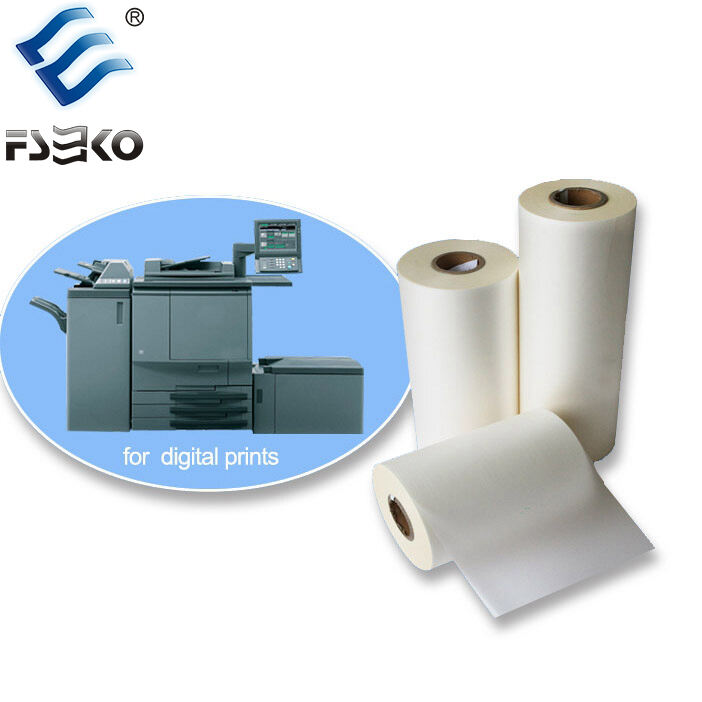Understanding the Core Properties of Strong Adhesive Lamination Film
Key Adhesive Properties That Determine Bonding Performance
The effectiveness of strong adhesive lamination film depends heavily on finding the right mix between tackiness, how well it resists peeling off, and its ability to hold up against shearing forces. Most quality films need at least 30 Newtons per 25 millimeters of peel strength to meet what's considered standard in the industry these days. These specs help keep things intact even when subjected to various stresses. On the flip side, some lower tack versions let workers adjust positioning before finalizing the bond during installation. Recent research from last year showed something interesting about solvent free options too. They work great with around 98% of different surfaces as long as those surfaces have surface energy readings somewhere between 36 and 42 dynes per centimeter. That makes them pretty versatile for most applications out there.
How Adhesive Strength and Cohesive Durability Influence Long-Term Reliability
The ability of an adhesive to resist breaking from within, what we call cohesive strength, really matters when materials need to last in changing conditions. Take high cohesion acrylic films for example these can hold onto about 90 percent of their original stickiness even after going through a thousand humidity tests. That's pretty impressive compared to rubber based glues which tend to lose around 35 percent of their grip under similar testing. Because of this superior performance, many manufacturers turn to acrylic adhesives for things like car dashboards and billboards that face extreme temperature changes throughout the year sometimes hitting differences over seventy degrees Celsius between day and night.
The Impact of Film Thickness, Flexibility, and Surface Finish on Adhesion
| Parameter | Optimal Range | Performance Impact |
|---|---|---|
| Thickness | 25—50 microns | Thinner films reduce delamination risk |
| Flexibility | ≥300% elongation | Prevents cracking on curved surfaces |
| Surface Finish | Matte/Glossy Options | Matte finishes improve ink adhesion by 40% |
Films under 30 microns offer optimal flexibility without compromising bond strength, making them well-suited for textured substrates like embossed leather or corrugated plastics.
Matching Adhesive Chemistry to Application and Environmental Needs
Water-based films: Sustainable lamination with moderate moisture resistance
More people are turning to water based adhesive films because they're better for the environment. These films cut down on volatile organic compounds (VOCs) by around 35 to maybe even 60 percent compared to those old solvent based options. They work great inside where things stay dry most of the time, think bookbinding projects or putting together those fancy decorative laminates for furniture. But watch out when humidity gets really high, like over 85% relative humidity. That's when these adhesives start to struggle and not hold up so well anymore. To fix this problem, manufacturers usually throw in some cross linking agents which help make them more resistant to moisture without breaking any of the EPA rules about emissions. It's all part of finding that sweet spot between staying compliant and getting good results from the product.
Solvent-based films: Maximizing bond strength in demanding industrial applications
Solvent based systems tend to give about 20 to 40 percent better initial stickiness compared to water based alternatives. That's why many industries still rely on them for things like airplane parts, car interior components, and tough packaging materials. What makes these solvents so effective is how they clean away surface grime, allowing bonds to form directly on oily metal surfaces or tricky plastics such as polyethylene that usually resist adhesion. Of course there are downsides too. The ventilation requirements can be a pain because of those volatile organic compounds floating around. But when looking at the big picture, most manufacturers find it worth the hassle since these products cure much faster and hold up remarkably well even in really harsh conditions from minus 40 degrees Celsius all the way up to 150 degrees Celsius. The extra money spent on proper facilities ends up paying off in long term performance.
Curing mechanisms and performance trade-offs by adhesive type
The way materials are cured makes a big difference in how they perform over time. When we talk about thermally cured epoxies, these create really strong bonds that hold up well under weight and stress, making them great for things that need structural integrity. On the flip side, UV curable acrylics let manufacturers speed up their production processes because they set quickly when exposed to light. For water based systems that use VAE emulsions, there's been some interesting research showing better moisture resistance comes from getting the curing process just right. A study published last year looked at this effect on coating adhesion. And then there are heat activated films which demand pretty exact temperature control around plus or minus 5 degrees Celsius. Getting this right activates the adhesive properties without melting or otherwise harming sensitive materials like PVC or polypropylene during application.
Ensuring Compatibility Across Substrates and Production Processes
Bonding Effectiveness on Plastics, Metals, Paperboard, and Composites
Getting good lamination results really comes down to finding the right match between what kind of adhesive we're using and the material it needs to stick to. When working with those tricky low surface energy plastics such as polyethylene, there are ways around this problem. Plasma treatments work wonders or sometimes applying special primers will do the trick too. These methods basically boost the surface energy level from below 30 mN/m all the way up past 45 mN/m so that things actually stick properly. With metal surfaces though, another consideration pops up. We need adhesives that fight off corrosion because otherwise oxidation just eats away at the bond over time. Some interesting findings come from industry testing labs. They discovered something surprising about film thickness when applied to paperboard substrates. Thinner films measuring between 25 and 35 microns maintained nearly perfect fiber tear retention at around 98%, while much thicker 50 micron films performed significantly worse with only about 72% retention rates. So thinner isn't always worse after all!
Overcoming Surface Energy and Porosity Challenges in Multi-Material Lamination
When bonding different types of materials together, especially things like porous composites alongside non-porous metals, we need special adhesives that work for each specific combination. A recent study from Smithers Rapra showed that certain hydrophobic silicone modified adhesives can hold about 94 percent of their original strength even after going through 500 cycles of high humidity when used on wood plastic composites, mainly because they stop moisture from being wicked away. For tougher surfaces such as recycled cardboard, manufacturers often look for adhesives that have around 15 to 25 percent more viscosity. This helps prevent the glue from sinking too deep into the material while still covering all the necessary areas properly. Viscoelastic adhesives are particularly good at handling situations where materials expand differently when heated or cooled. Take aluminum which expands at about 23 micrometers per meter per degree Kelvin versus polycarbonate expanding much faster at 65 micrometers per meter per degree Kelvin. These viscoelastic formulas can actually handle movements of plus or minus 1.2 millimeters across temperature ranges from minus 40 degrees Celsius right up to 85 degrees Celsius.
Optimizing Lamination Process Parameters for Maximum Bond Strength
Roll coating vs. spray application: Precision and uniformity in adhesive deposition
When it comes to adhesive coverage, roll coating gets around 95% uniformity give or take 2% on those smooth materials like foil and plastic film. That makes it a go to method for fast moving packaging operations where consistency matters most. Spray application isn't quite as consistent at about 80 to 85% but works really well on rougher textures. Think embossed leather or those fancy structured plastics where the nozzle can actually follow the bumps and curves in three dimensions. The right viscosity is important too. For roll coating we're looking at thicker stuff between 1500 and 3000 centipoise while spray needs something much thinner, usually somewhere between 200 and 500 cP to atomize properly.
| Parameter | Roll Coating | Spray Application |
|---|---|---|
| Surface Compatibility | Smooth, rigid substrates | Textured, uneven surfaces |
| Adhesive Waste | <5% | 12-18% |
| Line Speed | Up to 1,200 ft/min | 600-800 ft/min |
Critical role of temperature, pressure, and dwell time in strong adhesive lamination film activation
Activation parameters vary by chemistry: UV-cured acrylics need 70—90°C for 2—4 seconds, whereas solvent-based polyurethanes require 120—140°C for 8—12 seconds (2024 Film Lamination Process Study). Pressure impacts bond strength non-linearly—doubling nip pressure from 15 PSI to 30 PSI boosts strength by 40%, but exceeding 35 PSI risks squeeze-out, according to PIRA International (2023).
Real-world case: Fine-tuning parameters for consistent adhesion in high-speed packaging
A frozen food packaging manufacturer reduced delamination defects by 83% by optimizing three key variables:
- Dwell time: Reduced from 1.2 sec to 0.8 sec to align with increased line speed
- Temperature profile: Switched from uniform 85°C to a 92°C/78°C gradient heating system
- Pressure roll alignment: Introduced laser-guided parallelism checks every 30 minutes
These adjustments ensured 99.2% adhesion integrity across over 20,000 thermal shock cycles (-40°C to 120°C).
Evaluating Long-Term Durability in Challenging End-Use Environments
Resistance to UV Exposure, Humidity, and Thermal Cycling in Outdoor Applications
Lamination films used as adhesives tend to break down over time when exposed to sunlight, moisture, and changing temperatures. Testing under accelerated conditions following ASTM G154 standards reveals something interesting: after around 2,000 hours of UV exposure, these films typically hold only between 65 and 78 percent of their initial peel strength. When subjected to humidity cycles at 85% relative humidity and 50 degrees Celsius, the tack force drops anywhere from 30 to 50%. Industry experts recommend incorporating UV-stabilized acrylic backing materials along with hydrophobic formulas that stop plasticizers from migrating. These approaches help maintain better performance outdoors where environmental factors constantly attack the material integrity.
Peel Strength Retention and Failure Analysis Under Prolonged Stress
According to a recent Smithers Rapra study looking at around 120 different industrial systems, films that kept about 80% or more of their original peel strength after five years in simulated conditions had three things going for them. First, they used crosslinked polymer matrices. Second, the adhesive layer needed to be at least 50 micrometers thick. And third, there was this really important factor called surface energy matching within plus or minus 3 dynes per centimeter. What's interesting is how failures change over time too. When something stays under stress longer, it tends to fail not because the adhesive breaks down first (which usually means bad surface compatibility), but because the material itself starts to wear out cohesively. That's why many manufacturers now rely on these accelerated aging tests, which basically squeeze what would normally take several years of outdoor exposure into just 8 to 12 weeks inside controlled lab environments.
Balancing Initial Tack with Long-Term Cohesive Strength for Reliable Performance
Durability really comes down to getting viscoelastic properties just right. When materials have a storage modulus between 0.5 and 1.5 MPa at room temperature, they wet surfaces quickly during application. At the same time, keeping the loss tangent below 0.35 helps prevent deformation when weight is applied for extended periods. Field tests across various industries indicate that coatings which start with peel strengths of around 12 to 18 Newtons per 25mm width maintain their integrity remarkably well. Even after going through over 1,000 cycles of extreme temperature changes without moisture exposure, these materials typically retain about 85% of their original strength. This kind of performance makes them ideal for car manufacturing and building construction projects where products need to last decade after decade without failing unexpectedly.
Frequently Asked Questions
What are the key properties of a strong adhesive lamination film?
The key properties include tackiness, peel strength, shear resistance, cohesive durability, and adaptability to various environmental conditions. These properties ensure that the film performs effectively under different stresses.
Why are water-based films considered more environmentally friendly?
Water-based films reduce volatile organic compounds (VOCs) by 35% to 60% compared to solvent-based options, making them a more sustainable choice for indoor applications where humidity is controlled.
How do solvent-based films improve bond strength?
Solvent-based films offer 20% to 40% better initial stickiness. They effectively clean surface grime, allowing better bonding on oily metal surfaces and challenging plastics like polyethylene.
What factors influence adhesive activation in lamination processes?
Temperature, pressure, and dwell time are crucial in optimizing adhesive activation. Different adhesive chemistries have specific requirements for these parameters to achieve maximum bond strength.
What is the impact of environmental exposure on adhesive films?
Exposure to UV, humidity, and thermal cycling can degrade adhesive films over time. However, using UV-stabilized backing materials and hydrophobic formulas can help maintain performance under harsh conditions.
Table of Contents
- Understanding the Core Properties of Strong Adhesive Lamination Film
- Matching Adhesive Chemistry to Application and Environmental Needs
- Ensuring Compatibility Across Substrates and Production Processes
- Optimizing Lamination Process Parameters for Maximum Bond Strength
- Evaluating Long-Term Durability in Challenging End-Use Environments


